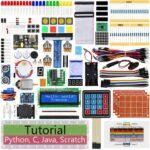Have you ever wondered what it takes to make the most of your Raspberry Pi 5? It’s not just about the hardware; it’s also about the languages you use to communicate with it. Programming languages are the key to unlocking the full potential of your Raspberry Pi 5. But with so many options out there, where do you start?
In this article, we’ll explore the top 5 Raspberry Pi 5 programming languages that are ideal for beginners. So, grab your Raspberry Pi 5, and let’s dive into the world of coding!
 Raspberry Pi 4 Model B 2019 Quad Core 64 Bit WiFi Bluetooth (4GB)
Raspberry Pi 4 Model B 2019 Quad Core 64 Bit WiFi Bluetooth (4GB)
Raspberry Pi 4 Model B is the last (till today) product in the popular Raspberry Pi range of computers. It offers ground-breaking increases in processor speed, multimedia performance, memory, and connectivity compared to the prior-generation Raspberry Pi 3 Model B+, while retaining backwards compatibility and similar power consumption. For the end user, Raspberry Pi 4 Model B provides desktop performance comparable to entry-level x86 PC systems.
This product’s key features include a high-performance 64-bit quad-core processor, dual-display support at resolutions up to 4K via a pair of micro-HDMI ports, hardware video decode at up to 4Kp60, 4GB of RAM, dual-band 2. 4/5. 0 GHz wireless LAN, Bluetooth 5. 0, Gigabit Ethernet, USB 3. 0, and PoE capability (via a separate PoE HAT add-on).
1: Python – The Swiss Army Knife of Raspberry Pi 5 Programming
When it comes to programming languages for Raspberry Pi 5, Python is the undisputed champion. It’s like the Swiss Army knife of programming languages—versatile, powerful, and easy to learn. Whether you’re a beginner or an experienced coder, Python offers a user-friendly syntax that makes it a breeze to work with it.
Imagine this scenario: You’ve just unboxed your brand-new Raspberry Pi 5, and you want to create a program that blinks an LED. With Python, you can do it in just a few lines of code. It’s that simple! Python’s extensive libraries and vibrant community also mean that you can find resources and support easily, making it an excellent choice for Raspberry Pi 5 enthusiasts.
2: JavaScript – Web Development and Beyond
JavaScript isn’t just for web development; it’s also a fantastic choice for Raspberry Pi 5 projects that involve building interactive web applications or controlling hardware through web interfaces. With it’s enhanced processing power, you can create web-based control panels for your projects using JavaScript.
Picture this: You’re building a smart home system with Raspberry Pi 5. You want to control your lights, thermostat, and security cameras through a web interface. JavaScript allows you to create a responsive and user-friendly web app for this purpose. It’s a language that bridges the gap between web development and hardware control.
3: Scratch – Perfect for Young Programmers
If you have young aspiring programmers in your household, Scratch is an excellent choice. It’s a visual programming language that’s incredibly user-friendly, making it perfect for kids and beginners. With Raspberry Pi 5, you can introduce your children to the world of coding and electronics in a fun and engaging way.
Imagine your child creating a game where a character controlled by Raspberry Pi 5 moves around and interacts with objects on the screen. Scratch makes it possible, and it’s a fantastic tool for sparking creativity and curiosity.

4: C/C++ – Harnessing the Full Power of Raspberry Pi 5
For those who want to dive deep into the hardware and harness the full power of it, C/C++ is the way to go. While it may have a steeper learning curve compared to Python or Scratch, C/C++ provides precise control over the hardware, making it ideal for building resource-intensive applications and drivers.
Consider this: You’re developing a custom robotic arm controlled by your Raspberry Pi 5. To ensure precise movement and real-time response, C/C++ allows you to write code that directly communicates with the GPIO pins and sensors, delivering unmatched performance.
5: Java – A Reliable Choice for Raspberry Pi 5
Java, known for its platform independence, is a reliable choice for Raspberry Pi 5 programming. With it’s improved processing capabilities, Java can run smoothly, making it suitable for a wide range of applications, including IoT projects and Android app development for Raspberry Pi 5.
Think about this scenario: You’re working on an IoT project that involves collecting sensor data and sending it to the cloud. Java’s robust libraries and networking capabilities enable you to develop a stable and secure solution on your Raspberry Pi 5.
In Conclusion Choosing the right programming language for your Raspberry Pi 5 project can greatly impact your experience and the success of your endeavors. Each of these five languages—Python, JavaScript, Scratch, C/C++, and Java—offers unique advantages and is well-suited for specific tasks and skill levels.
So, which language will you choose to unlock the potential of your Raspberry Pi 5? Whether you opt for the simplicity of Python, the versatility of JavaScript, the kid-friendly nature of Scratch, the power of C/C++, or the reliability of Java, remember that it is a powerful tool waiting for you to unleash your creativity and innovation.
It’s time to pick a language, fire up your interest and Raspberry Pi, and embark on your coding adventure. The world of Raspberry Pi 5 programming is at your fingertips—where will you take it?
Now loading...






